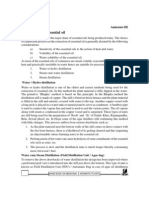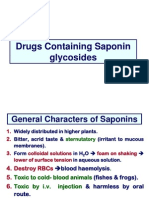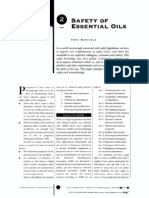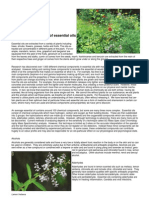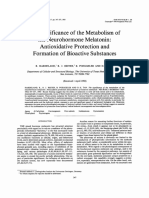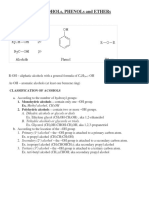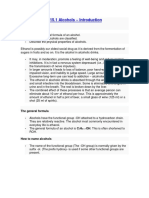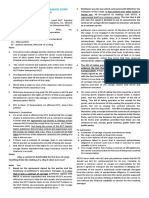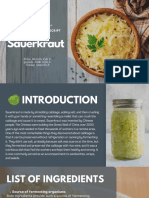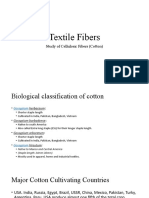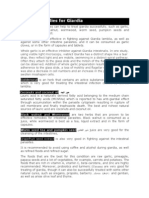Aldehydes and Ketones
Aldehydes and Ketones
Uploaded by
Shaira Mae CuevillasCopyright:
Available Formats
Aldehydes and Ketones
Aldehydes and Ketones
Uploaded by
Shaira Mae CuevillasOriginal Description:
Copyright
Available Formats
Share this document
Did you find this document useful?
Is this content inappropriate?
Copyright:
Available Formats
Aldehydes and Ketones
Aldehydes and Ketones
Uploaded by
Shaira Mae CuevillasCopyright:
Available Formats
September 25 CHEMISTRY 1 LECTURE
MENU
1. Commercially important alcohols
2. Naming Aldehydes and Ketones
3. Physical Properties of Aldehydes and Ketones
4. Reactions of Aldehydes and Ketones
5. Keto-Enol Tautomerism
Commercially Important Alcohols
1. Methanol CH
3
OH (wood alcohol). It is used as
solvent in
many industrial reactions. Methyl alcohol should never
be
bbbbbb applied directly to the body, neither should the
vapors be
inhaled because this substance can be absorbed through
the
skin and through the respiratory tract. Ingestion of as
little as
15 ml can cause blindness, and 30 ml can cause death.
Methyl alcohol can be derived by heating hard wood
in
a limited supply of air.
CO
CH
3
COOH
Coal or methane
[O]
CO
2H
2
CH
3
OH
O
2
acetic acid
CH
2
O
It is prepared commercially from CO.
formaldehyde
2. Ethanol CH
3
CH
2
OH (grain alcohol). In the hospital,
the word
Alcohol means ethyl alcohol. One of its important
property is
its ability to denature protein. Because of this, ethanol is
widely used as an antiseptic.
As an antiseptic it works best at a concentration of
70 %
in water. Pure alcohol coagulates protein on contact. If
pure
alcohol is poured over a germ, it would penetrate the cell
wall
of that organism in all directions, coagulating the protein just
inside the cell wall. This ring of coagulated protein would
then prevent the alcohol from penetrating farther into the
cell, and no more coagulation would take place. At this time
the cell would become dormant, but not dead. Under proper
conditions, the organism could again begin to function.
However, if only 70% is poured over a germ, the diluted
alcohol also coagulates the protein but at a slower rate, so
that it penetrates all the way through the cell before
coagulation can block it. Then all the cells are coagulated,
and the organism dies.
Ethanol can also be used for sponge baths to reduce the
fever of a patient. When alcohol is placed on the skin it
evaporates rapidly. To evaporate, alcohol requires heat,
which heat comes from the patients skin. So the alcohol
removes the heat from the patients skin and so lower the
body temperature.
A sponge bath will do the same thing, but water
evaporates more slowly so the heat evaporates more slowly
as well. Water sponge baths are in common use in more
hospitals because they are cheaper. For children, however,
it is kinder to allow them to play in a tepid bath. The alcohol
sponge bath cools them too rapidly and is uncomfortable.
Since alcohol is flammable it cannot be used in a room
where oxygen is in use.
Alcohol is used as a solvent for many substances.
Alcohol solutions are called tinctures. Tincture of iodine
consists of iodine dissolved in alcohol.
Ethyl alcohol is also used as a beverage. Its
concentration in drinks is expressed as proof. Alcohol
slows reaction time, so driving under the influence of alcohol
can be very dangerous. Alcohol is not a stimulant; it actually
depresses the nervous system and can remove an
individuals normal inhibitions. Excessive use of alcohol may
cause destruction of the liver, a condition known as cirrhosis.
Ethanol is obtained by fermentation of sugar from plant
sources. The starches present in grains can be converted
into sugar by malt. The sugar thus produced can be
fermented under the influence of the enzymes in yeast to
yield ethyl alcohol.
3. Isopropyl alcohol CH
3
CHOHCH
3
This is toxic and
should not
be taken internally. Since it is not absorbed through the
skin it
is commonly used as rubbing alcohol and as an
astringent.
4. Ethylene Glycol CH
2
CH
2
1,2-ethanediol
OH OH
Example of a dihydric alcohol
Has a high boiling point due to extensive H-bonding
Completely miscible with water
If taken internally, it is extremely toxic because it is
oxidized in the liver to oxalic acid. Oxalic acid crystallizes
as Ca oxalate, in the kidneys, causing renal damage
which can lead to kidney failure and death.
Antidote for ethylene glycol poisoning (and also for
CH
3
OH) is administration of high levels of ethyl alcohol.
This causes the liver enzymes to oxidize the ethyl
alcohol rather than the poisonous alcohol, which is
present in smaller amounts.
Ethylene glycol is used in preparations to moisten skin;
as antifreeze in car radiators; and as raw material in the
manufacture of the polymer Dacron.
H H H
5. Glycerol HCCCH sometimes called
glycerin
OH OH OH 1,2,3-propanetriol
In terms of body chemistry, glycerol is an important
alcohol especially as a constituent of fats.
By-product of soap manufacture and is used in the
preparation of cosmetics, hand lotions and in
suppositories
Used in the lab as lubricants for rubber tubing and
stoppers
When treated with nitric acid, glycerin forms
nitroglycerin, an explosive. Medicinally, nitroglycerin is
used to treat angina or heart pain. It causes dilation of
the coronary arteries, thus increasing the supply of blood
to the heart muscles.
Other alcohols include menthol, a cyclic alcohol, it has
a cooling, soothing effect and so is used as an ingredient
in cosmetics and shaving lotions; also in cough drops
and nasal sprays; alcohols of biologic importance
include cholesterol, retinol (Vitamin A) and tocopherol
(Vitamin E)
ALDEHYDES AND KETONES
1. NomenclatureAldehydes O
Aldehydes have the general formula RCH
Functional group, like ketone, is carbonyl group, C=O
The term aldehyde comes from the words alcohol
dehydration
Primary alcohol
oxidation
aldehyde
The IUPAC Names for aldehydes end in al. To name
an aldehyde in the IUPAC System, take the name of the
longest chain containing the aldehyde group, drop the
ending e , and replace it with the ending al. The
aldehyde group is always at the end of the chain, at
Carbon 1, with that number being understood and not
written.
The common name makes use of the trivial root and the
prefix aldehyde.
IUPAC NAME COMMON NAME
methanol
oxidation
methanal HCHO
(formaldehyde)
ethanol
oxidation
ethanal CH
3
CHO
(acetaldehyde)
propanol
oxidation
propanal CH
3
CH
2
CHO
(propionaldehyde)
butanol
oxidation
butanal CH
3
CH
2
CH
2
CHO
(butyraldehyde)
Name the following compound
Br
CH
3
CHCHCHCH
2
CH
2
CH
2
CHO 6-bromo-5,7-
dimethyloctanal
CH
3
CH
3
CH
3
*Draw the structure
CH
3
CHCH
2
CHO (a) 4,4-dichloro-2,3-
dimethylpentanal
3-methylbutanal (b) 2,3-dichloropropanal
(c) 3,5-dimethyloctanal
Aromatic aldehydes have the general formula ArCHO
CH
3
+ [O]
catalyst
CHO
Toluene
Benzaldehyde
Benzaldehyde is a colorless, oily liquid with a cherry-
almond
like odor, used in the preparation of flavoring agents,
perfumes, drugs, and dyes.
H H H
HO CHO CC
CO
H H
CH
3
O
Vanillin Cinnamic aldehyde
Vanillin occurs in vanilla beans Or cinnamaldehyde is
present and gives the particular taste in oil of
cinnamon, an oil found
and odor to vanilla extract. in cinnamon bark.
Both vanillin and cinnamic aldehyde can be prepared
synthetically
and both are used as flavoring agents.
2. NomenclatureKetones O
Ketones have the general formula RCR
Functional group, like aldehyde is, carbonyl group, C=O
The oxidation of a secondary alcohol yields a ketone.
The oxygen atom from the oxidizing agent reacts with
the H from the OH group and with the H attached to the
same C as the OH group, forming water and a new
class of compounds called ketones.
The carbonyl group in an aldehyde is at the end of a
chain, but in a ketone it is not.
H
CH
3
CCH
3
+ [O] CH
3
CCH
3
+ H
2
O
OH O
2-propanol propanone
(isopropyl alcohol) (acetone)
H
CH
3
CCH
2
CH
3
+ [O] CH
3
CCH
2
CH
3
OH O
2-butanol butanone
In the IUPAC System, the names of ketones end in
one. To name a ketone, take the name of the longest
alkane containing the carbonyl group, drop the ending
e, and add
one.
In the common naming system, each alkyl group
attached to the carbonyl group is named and the word
ketone is added afterward. Thus, butanone is commonly
known as methyl ethyl ketone.
Name the following compounds :
1. CH
3
CH
2
CCH
2
CH
2
CH
3
3-hexanone (ethylpropylketone)
O
Cl
2. CH
3
CCH
2
CCH
3
4,4-dichloro-2-pentanone
Cl O
Draw the structure of the following compounds:
1. 2,2-dimethyl-3-pentanone
2. methylethylketone
3. 3-chlorobutanone
4. hydroxyacetone
Aromatic ketones have the general formula ArCOAr or
ArCOR. The simplest aromatic ketone is acetophenone.
CCH
3
CCH
2
Cl
O O
Acetophenone
chloroacetophenone
Acetophenone has been used as
Chloroacetophenone is a
hypnotic but has been supplanted lachrymator and is
used
for this purpose by newer and as a tear gas.
safer drugs.
Among the aromatic ketones in the body are the sex
hormones estrone, progesterone, testosterone, and
androsterone.
3. Physical properties of Aldehydes and Ketones
C=O is polar
Liquid aldehydes and ketonesIMFA is dipole-dipole
Lower BP than alcohol because no Hbonding, and
RCOOH
Low mw RCHO and RCOR are more soluble in water
than are nonpolar compounds of comparable mw
(because the O atom of the C=O are Hbond
acceptors)
HCHO, CH
3
CHO and CH
3
COCH
3
(acetone) are infinitely
soluble in water. As the HC of the molecule increases,
aldehydes and ketones become less soluble in water.
Most aldehydes and ketones have strong odors
Ketones odorgenerally pleasant
perfumes
flavoring agents
aldehyde odor
low mwnot pleasant
high mwpleasant (perfume)
4. Characteristic reactions of Aldehydes and Ketones
Oxidation to Carboxylic Acid by a variety of Oxidizing
Agents
O K
2
Cr
2
O
7
O
H OH
H
2
SO
4
Hexanal hexanoic acid
Liquid aldehydes @ RT are so sensitive to oxidation
must be protected from contact with air during storage; done
by sealing in container with nitrogen gas
O O
CH + O
2
C
OH
Benzaldehyde Benzoic Acid
Ketones resist oxidation
Aldehyde Tollens Reagent Ag mirror (black/gray)
Ketone mild [O] No reaction
O
RCHO + 2Ag(NH
3
)
2
+
+ 3OH
-
RCO
-
+ 2Ag + 4NH
3
+ 2H
2
O
Carboxylic acid
Because of high cost, no longer used for oxidation of aldehydes but
still used for making (silvering) mirrors
Reduction
Aldehydes are reduced to primary alcohols.
Ketones are reduced to secondary alcohols.
O
H + H
2
TRANSITION METAL
OH
PENTANAL
CATALYST
1-PENTANOL
O + H
2
TRANSITION METAL
OH
CATALYST
CYCLOPENTANONE
CYCLOPENTANOL
Reduction of C=O slower than C=C
NaBH
4
O
-
H
3
O
+
=O H
OH
H
NaBH
4
reagent commonly used in the Lab for the reduction
of
aldehydes and ketones
its advantage over H
2
is that it does not reduce
C=C bonds
because there is no polarity on C=C bond.
Chemical reactions for distinguishing
aldehydes and ketones are based on the fact
that aldehydes are very easily oxidized to
acids, but ketones are not easily further
oxidized.
Mild OA like Tollens rgt and Fehlings rgt
are easily reduced by aldehydes to silver mirror
and brick red ppt of Cu
2
O respectively.
Aromatic aldehydes reduce Tollens but not
Fehlings reagent.
Ketones do not reduce either of the two
rgts.
Tollens test is based on the ability of the
aldehyde group to reduce silver ion in solution,
forming either a black deposit of free silver or a
silver mirror.
The aldehyde group is oxidized to acid in
the reaction.
Tollens reagent is made by reacting silver
nitrate solution with dilute ammonium
hydroxide.
Aldehydes and ketones may also be
differen-tiated by the Schiffs Fuchsin test. The
rxn with aldehydes produces a violet or
magenta color.
Methyl carbonyl compounds like
acetaldehyde and acetone form a yellow
crystalline ppt by rxn with I
2
in the presence of
dilute alcohol.
ALDEHYDES AND KETONES are
compounds that upon oxidation may produce
acids, react with halogen in the presence of a
base by substitution of -hydrogen (haloform
reaction). The rxn involves the removal of an
-hydrogen to form an enolate ion. Addition of
halogen to the enolate ion will initiate faster
substitution of -hydrogen by nucleophilic
halogen. Presence of electron attracting
halogen on the the -Carbon initiates further
replacement of remaining -hydrogen by
halogen. The resulting -ketone is readily
attacked by a base to initiate a CC bond
cleavage.
The reaction is represented as:
O O
-
O
RCCH
3
+ OH
-
RC=CH
2
RC
CH
3
+ H
2
O
+ I
2
ONa O O
CHI
3
+ RC=O RCI
3
RC
CH
2
I + I
-
Iodoform (yellow crystals)
Aldehydes and ketones with COCH
3
(methyl ketone) react similarly with Na
Nitroprusside which produce red blood solution
that eventually changes to wine red upon
addition of acetic acid. Absence of methyl
ketones changes blood red solution to yellow.
Schiffs reagent (fuchsin dye [magenta
color] + SO
2
) chemical name is bis-N-sulfuric
acid of p-rosaniline hydrochloride, is purple in
the presence of aldehydes but is very pale pink
in the presence of ketones. It is considered as
a general test for aldehydes since even
aromatic aldehydes give positive purple test.
Aldehydes Ag
mirror
TOLLENS
Ketones No
reaction
Aldehydes
Cu
2
O brick red
FEHLINGS
Ketones No
reaction
Tollens Ag
Mirror
Aromatic aldehydes
Fehlings No
reaction
Aldehydes
violet/magenta
SCHIFFS FUCHSIN TEST
Ketones very pale
pink
Methyl CH
3
CHO
yellow
carbonyl
IODINE crystals
crystalline
compounds CH
3
COCH
3
dilute alkali
precipitate
EXPERIMENTAL RESULTS
I. Physical Properties
Solubility : in H
2
O in
ethanol
HCHO soluble
soluble
CH
3
CHO soluble
soluble
Butyraldehyde soluble
soluble
Benzaldehyde insoluble
soluble
Acetone soluble
soluble
II. Chemical properties
Test for HCHO (Hehners Resorcinol Test)
method used for detecting the
presence of
methanol in alcoholic beverages;
specific
test for HCHO and indirectly for
methanol.
HCHO
resorcinol + concd sulfuric acid
pink-red color
at
junction of
2 liquids
CH
3
OH
CH
3
CH
2
OH No
reaction
III. Oxidation by Silver ion (Tollens Reagent)
HCHO + AgNO
3
soln + NH
3
HCOOH +
Ag
0
gray/silver ppt
IV. Oxidation by Copper ion (Fehlings /
Benedicts)
HCHO + Fehlings A + Fehlings B
Cu
2
O
brick
red ppt
Fehlings A CuSO
4
+ NaOH
Fehlings B sodium potassium tartrate
Benedicts Reagent CuSO
4
+ Na
2
CO
3
or
sometimes
Na citrate
V. Action of a Strong Base (Canizarro Rxn)
CH
3
CHO + NaOH CH
3
COONa +
CHI
3
yellow
iodoform
HCHO + NaOH No iodoform
formation
VI. General Test for Aldehydes
HCHO + Schiffs Rgt purple or
magenta
CH
3
COCH
3
+ Schiffs Rgt no reaction
(very pale
pink)
VII. Reaction with Phenylhydrazine
Certain cpds related to ammonia add to the
carbonyl group to form derivatives that are impt
chiefly for the characterization and
identification of aldehydes and ketones.
An aldehyde or ketone react with 2,4-
dinitro-
phenylhydrazine to form insol yellow or red
solid.
The products contain a carbon-nitrogen
double bond resulting from elimination of water
from the initial addition products.
C +:NH
2
NHC
6
H
5
CNHNHC
6
H
5
C=NNHC
6
H
5
+H
2
O
O phenylhydrazine OH
phenylhydrazone
Like ammonia, these derivatives of
ammonia are basic, and therefore react with
acids to form salts: phenylhydrazine
hydrochloride, C
6
H
5
NHNH
3
+
Cl
-
VIII. Autooxidation of Benzaldehyde
CHO + O
2
COOH
Benzaldehyde benzoic
acid
IX. Oxidation of Benzaldehyde
CHO + Tollens COOH
+ Ag gray
+ Fehlings NR
+ Schiffs rgt puple or
magenta
Preparation of HCHO:
CH
3
OH
pyridinium chlorochromate
HCHO
Hehners
Resorcinol test
pink-red color at
junction
specific test for HCHO and indirectly for
CH
3
OH
Preparation of CH
3
CHO:
H
2
SO
4
, HgSO
4
H
HC=CH + H
2
O HC
CH
H
O
What is paraldehyde?
Paraldehyde is C
6
H
12
O
3
is an acetaldehyde
polymer.
Acetaldehyde (b.p. 20
0
C) is often generated
from its higher boiling trimer by heating the trimer
with acid:
H O H
H
H
+ C C
3 CH
3
C=O CH
3
CH
3
acetaldehyde O O
paraldehyde
b.p. 20
0
C b.p.
125
0
H CH
3
Paraldehyde is a colorless, flammable, toxic liquid,
miscible with organic solvents, soluble in water;
melts @ 12.6
0
C, boils @ 125
0
C; used as a cheml
interme-diate, in medicine, and as a solvent; aka
para-acetaldehyde.
ALDEHYDES AND KETONES
o Aldehydes and ketones are functional
isomers.
o Both have the functional carbonyl group (-
C=O).
o Because of he great difference in the
electronegativity between C and O, a carbonyl
group has a
C and a
O (due to inductive
effect and pi delocalization).
The dipolar character of both groups result
in similar reactions:
1. addition of a variety of reagents at the
carbonyl group
2. reduction at the carbonyl group
3. condensation and polymerization
o Most aldehydes and ketones react by addition
at the carbonyl carbon, with groups like NH
3,
NaHSO
3
, HCN and RMgX. The addition
reactions are influenced by steric hindrance. If
the group attached to the carbonyl group are
large or bulky, some addition reactions are
completely prevented. Thus the addition of
NaHSO
3
or HCN occurs with aldehydes and
methyl ketones but not with other aliphatic
ketones.
TEST HCH
O
CH
3
CH
O
BUTANA
L
C
6
H
5
CH
O
ACETON
E
Odor
rrita-
ting
Irritating
irritating Almond-
like
fruity
Soly
In H2O
solu-
ble
soluble
soluble
insolubl
e
soluble
Soly solu-
in
C
2
H
5
O
H
ble soluble soluble soluble soluble
Tollen
s
Ag
0
mirror
Ag
0
mirror
Ag
0
mirror
Ag
0
mirror
negative
Feh-
lings
brick
red ppt
brick
red ppt
brick red
ppt
NR negative
Schiff
s
mage
nta
magen-
ta
magent
a
magent
a
pale pink
You might also like
- Experiment Properties of AlkenesDocument3 pagesExperiment Properties of AlkenesMei Hui100% (8)
- Tamanu Oil A Tropical Topical Remedy PDFDocument7 pagesTamanu Oil A Tropical Topical Remedy PDFIvana Milenkovic100% (1)
- UNITED CLAIMANTS ASSOCIATION OF NEA V NEA - DigestDocument2 pagesUNITED CLAIMANTS ASSOCIATION OF NEA V NEA - DigestShaira Mae Cuevillas100% (1)
- Duavit Vs CA DigestDocument1 pageDuavit Vs CA DigestShaira Mae Cuevillas100% (1)
- United Airlines Vs CaDocument1 pageUnited Airlines Vs CaShaira Mae CuevillasNo ratings yet
- Domingo Vs DBP DigestDocument2 pagesDomingo Vs DBP DigestShaira Mae Cuevillas0% (1)
- Cfi Soil Sampling and Analysis Method and GuidelinesDocument28 pagesCfi Soil Sampling and Analysis Method and GuidelinesThird WorldNo ratings yet
- The Basic Properties of Poly (Lactic Acid) Produced by The Direct Condensation Polymerization of Lactic AcidDocument10 pagesThe Basic Properties of Poly (Lactic Acid) Produced by The Direct Condensation Polymerization of Lactic AcidandoajpwdwNo ratings yet
- Granny Storm Crow's List - January 2014 PHYTODocument101 pagesGranny Storm Crow's List - January 2014 PHYTOElectroPig Von FökkenGrüüven100% (1)
- The Beginners Guide To Micro NichesDocument22 pagesThe Beginners Guide To Micro NicheselsaliliNo ratings yet
- Essential Oils ExtractionDocument60 pagesEssential Oils Extractionbilal sheikhNo ratings yet
- Second Round Cancer Cannabis Study NotesDocument15 pagesSecond Round Cancer Cannabis Study Notesguilherme_brandão_5No ratings yet
- Essential Oils IFA PresentationDocument21 pagesEssential Oils IFA PresentationNasir AhmedNo ratings yet
- A. Distillation of Essential OilDocument4 pagesA. Distillation of Essential OilUrsula BologaNo ratings yet
- Preservation by Food AdditivesDocument23 pagesPreservation by Food Additivesnoman_sheeraz7455No ratings yet
- Distillation of Alcohol in VodkaDocument3 pagesDistillation of Alcohol in VodkaHeather Gutierrez50% (6)
- TerpenesDocument33 pagesTerpenesوائل مصطفىNo ratings yet
- What Are CarotenoidsDocument18 pagesWhat Are CarotenoidsChandra ReddyNo ratings yet
- Steam Distillation ofDocument11 pagesSteam Distillation ofMunna Patel100% (2)
- Flavon OidsDocument25 pagesFlavon OidsalexpharmNo ratings yet
- Chemistry Project (Final)Document23 pagesChemistry Project (Final)Rohan PatelNo ratings yet
- Starch From Food To MedicinaDocument27 pagesStarch From Food To MedicinavhnsncNo ratings yet
- TerpenesDocument47 pagesTerpenesVenkatesh Sathya Harisyam100% (1)
- Steam Distillation ApparatusDocument4 pagesSteam Distillation ApparatusAshish VermaNo ratings yet
- Separation and Isolation of Phytochemicals RevDocument90 pagesSeparation and Isolation of Phytochemicals RevWendz BouvierNo ratings yet
- Lec 10 Drugs Containing Saponin GlycosidesDocument51 pagesLec 10 Drugs Containing Saponin GlycosidesSandhya Parameswaran100% (2)
- TanninsDocument39 pagesTanninsUmama WarrichNo ratings yet
- Organic Synthesis of VanillinDocument6 pagesOrganic Synthesis of VanillinSarah Alexander0% (1)
- Volatile Oils 1Document72 pagesVolatile Oils 1FaizNo ratings yet
- Pereiare Klotzsch) Belonging To Family: LeguminosaeDocument3 pagesPereiare Klotzsch) Belonging To Family: LeguminosaeHarish KakraniNo ratings yet
- C-13 Solutions EditedDocument128 pagesC-13 Solutions EditedJarena Ria ZolinaNo ratings yet
- Chapter 5 Flavonoids: Prof. Jian-Guang LuoDocument34 pagesChapter 5 Flavonoids: Prof. Jian-Guang LuoChic Afro100% (3)
- Essential OilDocument50 pagesEssential OilVikas Malanayak100% (2)
- Safety of Essential OilsDocument14 pagesSafety of Essential Oilsmyrtarom100% (2)
- Essential Oils On Your Gums and TeethDocument2 pagesEssential Oils On Your Gums and TeethGolden SunriseNo ratings yet
- Chemistry of Essential Oils and Perfumes Voll 1 & 2Document923 pagesChemistry of Essential Oils and Perfumes Voll 1 & 2UDGARD86% (7)
- Herbal Protein ExtractionDocument33 pagesHerbal Protein ExtractionSanjay PatilNo ratings yet
- Chemical Constituents Essential OilsDocument4 pagesChemical Constituents Essential OilsAhmed Garoot100% (1)
- Essential Oil Processing Unit Establishment Plan For Tinjure Herbs Cooperative, TehrathumDocument26 pagesEssential Oil Processing Unit Establishment Plan For Tinjure Herbs Cooperative, Tehrathumkhilendra gurung100% (4)
- Steam Distillation of Essential Oils From ClovesDocument7 pagesSteam Distillation of Essential Oils From ClovesKevin Chen100% (2)
- Profile of Essential Oil Industry FAO DAFF PDFDocument111 pagesProfile of Essential Oil Industry FAO DAFF PDFKaren SwanepoelNo ratings yet
- SaponinsDocument37 pagesSaponinsakayseref100% (1)
- Inbound 1012901290177963636Document22 pagesInbound 1012901290177963636Corine Nyd100% (1)
- Diluting Essential OilsDocument9 pagesDiluting Essential Oilsflore73No ratings yet
- Nine Essential Oils Everyday Use Barb LemkeDocument31 pagesNine Essential Oils Everyday Use Barb LemkeWalaa Elleithy100% (1)
- Pharmacognosy I (Part 6)Document88 pagesPharmacognosy I (Part 6)lovehope100% (4)
- Chemistry of Natural ProductDocument19 pagesChemistry of Natural Productsilvia fidyati0% (1)
- Pharmacognosy - DR AhmadDocument40 pagesPharmacognosy - DR AhmadOana Ungureanu100% (2)
- Biological Activity of Essential Oils andDocument61 pagesBiological Activity of Essential Oils and4negero100% (1)
- Beverages - Tea and CoffeeDocument53 pagesBeverages - Tea and CoffeeAfshan Pt TNo ratings yet
- The Significance of The Metabolism of The Neurohormone MelatoninDocument11 pagesThe Significance of The Metabolism of The Neurohormone MelatoninDaniel Díaz CarrascoNo ratings yet
- Pharmacognosy PDFDocument206 pagesPharmacognosy PDFJunelle CostesNo ratings yet
- A Fresh Start With Aromatherapy: The Oshadhi Aromatherapy Resource For Practitioners Spring 2007Document2 pagesA Fresh Start With Aromatherapy: The Oshadhi Aromatherapy Resource For Practitioners Spring 2007Nilamdeen Mohamed ZamilNo ratings yet
- Hydrosols or Distillation Waters Their Production, Safety, Efficacy and The Sales HypeDocument5 pagesHydrosols or Distillation Waters Their Production, Safety, Efficacy and The Sales HypeJozsef KunderNo ratings yet
- 38 - PC - 1 - 1 - Jul - Sep - 2011Document108 pages38 - PC - 1 - 1 - Jul - Sep - 2011Rosales Rosales Jesús100% (1)
- Steam Distillation Process of Essential OilDocument3 pagesSteam Distillation Process of Essential OilKaren Swanepoel100% (2)
- 1015Document43 pages1015pvrajivicas100% (1)
- Steam Distillation Vs Simple DistillationDocument5 pagesSteam Distillation Vs Simple DistillationAde Hidayat ChaniagoNo ratings yet
- Therapeutic and Medicinal Uses of Amalaki: A ReviewDocument13 pagesTherapeutic and Medicinal Uses of Amalaki: A ReviewChaitanya KumarNo ratings yet
- Extraction of Essential OilsDocument9 pagesExtraction of Essential OilsBhaby ForevherNo ratings yet
- Preparation of Phycocyanin Microcapsules and Its PropertiesDocument9 pagesPreparation of Phycocyanin Microcapsules and Its PropertiesUtami NainggolanNo ratings yet
- 5 Hydrocarbon Derivatives 2Document28 pages5 Hydrocarbon Derivatives 2Marivic TayabanNo ratings yet
- Alcohols CarbonylDocument8 pagesAlcohols CarbonylmuhajireenNo ratings yet
- Alcohols, Phenols, EthersDocument9 pagesAlcohols, Phenols, Ethersjane kangNo ratings yet
- Alcohol, Thiol and EtherDocument8 pagesAlcohol, Thiol and EtherbatacsidneyemmanuelNo ratings yet
- Module-12 - Aldehydes and KetonesDocument10 pagesModule-12 - Aldehydes and KetonesJohn Rey BusimeNo ratings yet
- As Chemistry Notes AlcoholDocument13 pagesAs Chemistry Notes AlcoholTai PanNo ratings yet
- 5a. ESTIPONA Vs LOBRIGO DigestDocument3 pages5a. ESTIPONA Vs LOBRIGO DigestShaira Mae CuevillasNo ratings yet
- FCD PAWNSHOP vs. UNION BANKDocument2 pagesFCD PAWNSHOP vs. UNION BANKShaira Mae CuevillasNo ratings yet
- Ramones-vs-Spouses-Guimoc-DigestDocument3 pagesRamones-vs-Spouses-Guimoc-DigestShaira Mae CuevillasNo ratings yet
- 4a. MORALES Vs BINAY DigestDocument9 pages4a. MORALES Vs BINAY DigestShaira Mae CuevillasNo ratings yet
- PAL Vs MIANODocument1 pagePAL Vs MIANOShaira Mae CuevillasNo ratings yet
- Alfonso Singson Cortal Vs Inaki Larrazabal GR No. 199107Document21 pagesAlfonso Singson Cortal Vs Inaki Larrazabal GR No. 199107Shaira Mae CuevillasNo ratings yet
- MATEO Vs DAR GR No. 186339Document23 pagesMATEO Vs DAR GR No. 186339Shaira Mae CuevillasNo ratings yet
- Necesito Vs ParasDocument2 pagesNecesito Vs ParasShaira Mae CuevillasNo ratings yet
- 64 Zulueta Vs PAN-AMDocument3 pages64 Zulueta Vs PAN-AMShaira Mae CuevillasNo ratings yet
- PAL Vs MIANODocument1 pagePAL Vs MIANOShaira Mae CuevillasNo ratings yet
- Cebu Salvage Vs Phil Assurance CorpDocument1 pageCebu Salvage Vs Phil Assurance CorpShaira Mae CuevillasNo ratings yet
- Proves That The Petroleum Previously Brought in Has Been Sold To A Duly Registered FEZ Locator and UsedDocument11 pagesProves That The Petroleum Previously Brought in Has Been Sold To A Duly Registered FEZ Locator and UsedShaira Mae CuevillasNo ratings yet
- Tax Cases - Batch 1Document42 pagesTax Cases - Batch 1Shaira Mae CuevillasNo ratings yet
- Most Rev. Pedro D. Arigo, Et - Al. V. Scott H. Swift, Et - Al. G.R. No. 206510 16 September 2014 PONENTE: J. Villarama, Jr. FactsDocument4 pagesMost Rev. Pedro D. Arigo, Et - Al. V. Scott H. Swift, Et - Al. G.R. No. 206510 16 September 2014 PONENTE: J. Villarama, Jr. FactsShaira Mae CuevillasNo ratings yet
- Act No. 4103 The Indeterminate Sentence LawDocument1 pageAct No. 4103 The Indeterminate Sentence LawShaira Mae CuevillasNo ratings yet
- Bagonggahasa Vs RomualdezDocument5 pagesBagonggahasa Vs RomualdezShaira Mae CuevillasNo ratings yet
- Santiago Vs AlikpalaDocument4 pagesSantiago Vs AlikpalaShaira Mae CuevillasNo ratings yet
- Nestle Phil Vs Uniwide Sales IncDocument9 pagesNestle Phil Vs Uniwide Sales IncShaira Mae CuevillasNo ratings yet
- Fosroc Reebol WB: Safety Data SheetDocument6 pagesFosroc Reebol WB: Safety Data SheetCommando crawlerNo ratings yet
- Organic Chem. NotesDocument80 pagesOrganic Chem. NoteselcarlsansNo ratings yet
- Ii 10 Food Pigments 2018Document30 pagesIi 10 Food Pigments 2018Moon jeaNo ratings yet
- Block s1 Product SauerkrautDocument16 pagesBlock s1 Product SauerkrautNikki Sofia QuijadaNo ratings yet
- Argus PolymersDocument11 pagesArgus PolymersIvan PavlovNo ratings yet
- Digestion Absorpton of ProteinsDocument21 pagesDigestion Absorpton of ProteinsSumihar Pasaribu100% (1)
- Carboxylic Acid - NotesDocument16 pagesCarboxylic Acid - NotesVANSHIKA GOELNo ratings yet
- 股市天眼 机构用指标公式Document9 pages股市天眼 机构用指标公式minismoker3No ratings yet
- 2 Year Chemistry Chapter # 11Document1 page2 Year Chemistry Chapter # 11Shahid Ali Saim AttariNo ratings yet
- Jay Tugend - Protein Synthesis Performance TaskDocument7 pagesJay Tugend - Protein Synthesis Performance Taskapi-673971695No ratings yet
- Textile Fibers: Study of Cellulosic Fibers (Cotton)Document31 pagesTextile Fibers: Study of Cellulosic Fibers (Cotton)Rashedul IslamNo ratings yet
- 1.1 Overview of Coconut:: Design and Fabrication of Coconut Fiber Extraction MachineDocument51 pages1.1 Overview of Coconut:: Design and Fabrication of Coconut Fiber Extraction Machineabhishek mNo ratings yet
- Herbal Remedies For GiardiaDocument1 pageHerbal Remedies For GiardiaSaad MotawéaNo ratings yet
- Spec Excellence CroissantDocument4 pagesSpec Excellence CroissantElla ArifaniNo ratings yet
- XXXcoppola 1978Document3 pagesXXXcoppola 1978Mauricio CeronNo ratings yet
- MSDS 04 - Meltonian Leather Cream P1Document15 pagesMSDS 04 - Meltonian Leather Cream P1janNo ratings yet
- Bio Finish in TextilesDocument35 pagesBio Finish in Textilessahu_disha100% (2)
- Organic Qualitative Analysis PDFDocument54 pagesOrganic Qualitative Analysis PDFRiyan WibawaNo ratings yet
- 360 PDFDocument2 pages360 PDFA MahmoodNo ratings yet
- Activated Carbon FiltrationDocument0 pagesActivated Carbon FiltrationIrhamNo ratings yet
- Reusable RespiratorsDocument12 pagesReusable RespiratorsMichael TadrosNo ratings yet
- Printed Circuit Board Manufacturers NewDocument302 pagesPrinted Circuit Board Manufacturers NewAnindya NandiNo ratings yet
- Article DairyDocument12 pagesArticle DairyLamiouna LamloumaNo ratings yet
- Poly SugaMulse D9Document2 pagesPoly SugaMulse D9mndmattNo ratings yet
- Hard Soft Acid Base TheoryDocument41 pagesHard Soft Acid Base Theory김영철No ratings yet
- LAS-Applied-Chem-Melc-2-for-students - For MergeDocument18 pagesLAS-Applied-Chem-Melc-2-for-students - For MergeKrize Anne CornejaNo ratings yet
- ChemistryDocument14 pagesChemistryNaveedNo ratings yet













